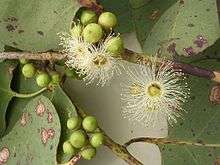Eucalyptus alba
| White gum | |
|---|---|
 | |
| Eucalyptus alba habit | |
| Scientific classification | |
| Kingdom: | Plantae |
| Clade: | Angiosperms |
| Clade: | Eudicots |
| Clade: | Rosids |
| Order: | Myrtales |
| Family: | Myrtaceae |
| Genus: | Eucalyptus |
| Species: | E. alba |
| Binomial name | |
| Eucalyptus alba | |

Eucalyptus alba, commonly known as white gum or khaki gum,[1] is a species of Eucalyptus which is native to Australia, Timor, and New Guinea. A dominant tree of open woodland, it reaches 18 m (59 ft) high with a spread of up to 15 m (49 ft).
Taxonomy
Eucalyptus alba was first described in 1826 by Carl Ludwig Blume, after being discovered by Caspar Georg Carl Reinwardt on Timor.[2] The specific epithet is the Latin word albus "white" and relates to the bark. Within the genus Eucalyptus, it belongs in the subgenus Symphyomyrtus.[3] Common names include white gum, poplar gum, khaki gum, wongoola, salmon gum and Timor white gum.[2]
Description
It grows as a small to medium tree from 5 to 18 m (16 to 59 ft) high with a spreading crown of 5 to 15 m (16 to 49 ft). The short trunk is often bent and has smooth grey to white powdery bark. Freshly-exposed new bark is pink.[3] The leathery ovate grey-green juvenile leaves are alternately arranged along the stems and measure 10–20 cm (3.9–7.9 in) long by 8–12 cm (3.1–4.7 in) wide. The adult leaves are ovate to lanceolate in shape and measure 5–12 cm (2.0–4.7 in) long by 5–8 cm (2.0–3.1 in) wide. The white flowers appear from August to November and can be profuse.[3]
The related Eucalyptus bigalerita is similar in appearance, but has larger leaves, buds and seed pods, and is found in alluvial flats.[4]
Distribution and habitat
A dominant tree in open woodlands, it is found from northeastern Western Australia across the Top End and into Queensland, as well as New Guinea and Timor.[3][5] It is often found on ridges and elevated areas,[4] often on poor soil.[3]
Uses
Eucalyptus alba has horticutural appeal as a small ornamental tree,[3] and can also attract birds.[6] It has also been used for fencing in northern Australia, while the flowers have been used in the beekeeping industry for honey.[3] It was valued by aborigines in the Northern Territory for firewood.[4]
See also
References
- ↑ Philip A. Clarke (2012). Australian plants as Aboriginal Tools. Rosenberg Publishing. ISBN 9781922013576.
- 1 2 "Eucalyptus alba Reinw. ex Blume". Australian Plant Name Index (APNI), IBIS database. Centre for Plant Biodiversity Research, Australian Government.
- 1 2 3 4 5 6 7 Elliot, Rodger W.; Jones, David L. (1986). "Eu-Go". In Elliot,Eliot, Rodger W. & Jones, David L. Encyclopaedia of Australian Plants suitable for cultivation. 4. Lothian Publishing. pp. 16–17. ISBN 0-85091-213-X.
- 1 2 3 Brock, John (2001) [1988]. Native plants of northern Australia. Frenchs Forest, New South Wales: New Holland Press. pp. 152, 156. ISBN 1-876334-67-3.
- ↑ "Eucalyptus alba". FloraBase. Western Australian Government Department of Parks and Wildlife.
- ↑ "White Gum (Eucalyptus alba)". Waterwise Plant Selector. The State of Queensland (Department of Natural Resources and Mines). 25 January 2012. Retrieved 5 May 2014.